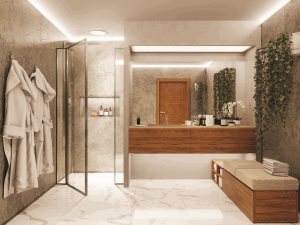Remodel with Universal Design in Mind
Local code ensures new construction homes and renovation projects reflect the requirements of the Americans with Disabilities Act. Universal design, on the other hand, does more than make living spaces more accessible for those with disabilities. It expands on regulations to create more user-friendly spaces regardless of abilities, resulting in more enjoyable, functional design.

Often, when people think of universal design, they’re thinking of design that reflects the needs of seniors who wish to age in place. That’s not always the case; universal design can also benefit families with special needs or simply serve as a smart investment for the future.
Principles of Universal Design
To better understand universal design and how it might apply to your project, consider how the National Association of the Remodeling Industry (NARI) describes the seven principles of universal design:
- Equitable use: The design is useful for people with diverse abilities.
- Flexibility: A wide range of individual preferences and abilities are accommodated.
- Simple and intuitive: The design is easy to understand regardless of the user’s experience, knowledge, language skills or current concentration level.
- Perceptible information: Any necessary information is effectively communicated to the user.
- Tolerance for error: Recognizing the possibility of accidents, the design minimizes potential hazards.
- Low physical effort: The design can be used efficiently and comfortably and with minimal fatigue.
- Size and space: An appropriate size and space is provided and isn’t affected by the user’s body size, posture or mobility.
Trends in Universal Design
The line between practical universal design and convenience features that drive up a room’s “cool factor” is growing increasingly blurry, according to Gary Grabowski, owner of Greater Home Services and a NARI Universal Design Certified Professional (UDCP).
One example is curbless showers, which eliminates a wheelchair barrier with an appealing design element.
In fact, bathrooms are among the highest demand remodeling projects Grabowski sees, especially for people whose mobility is affected, either personally or for a loved one who visits the home.
Other examples of on-trend universal design in the bathroom are floating, wall-hung vanities. Grabowski said the open floor space that design creates is enticing whether you need to be able to roll a wheelchair under it or not.
Other on-trend upgrades, such as motion-activated fixtures like fans, faucets and touch controls for showers, may feel like a bit of luxury in the short-term but could serve an accessibility role down the road.
In other parts of the house, luxury vinyl plank flooring continues to grow in popularity. Not only is it practical and easy to clean, it’s appealing from a design standpoint and also offers a barrier-free advantage.
Getting Started with Universal Design
Because most homeowners only explore universal design when there’s a specific need, the world of options is largely unknown. That’s why Grabowski recommends enlisting the help of a UDCP.
“Knowing universal design and the features that enhance accessibility for all kinds of scenarios, I can suggest ideas that people have never thought of to make a living space easier to use,” he said.
Grabowski also suggests starting at least a year out so you can make plans from a big picture perspective, including ancillary projects that could make your project even more successful.
Find more advice for your next remodeling project and certified remodelers in your area at
remodelingdoneright.com.
Photo courtesy of Getty Images
| 11/24/2021 9:19:51 AM |
0 comments